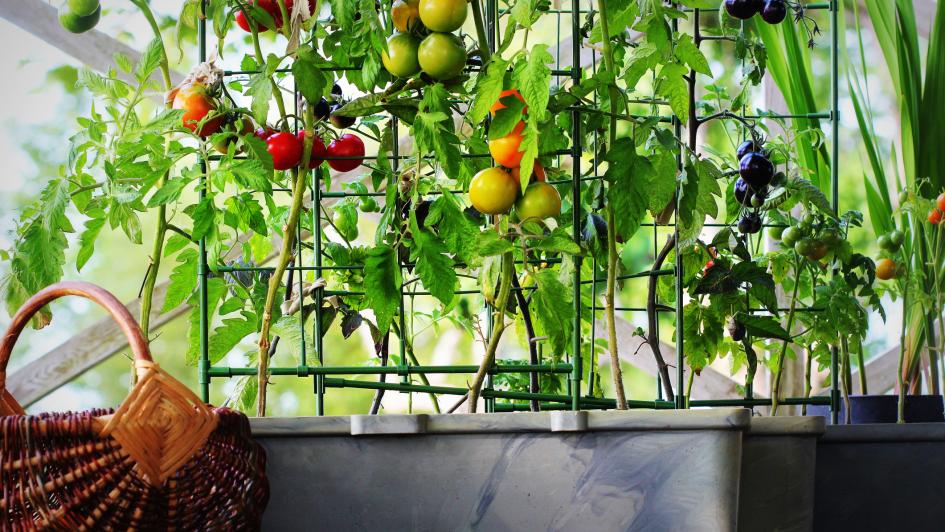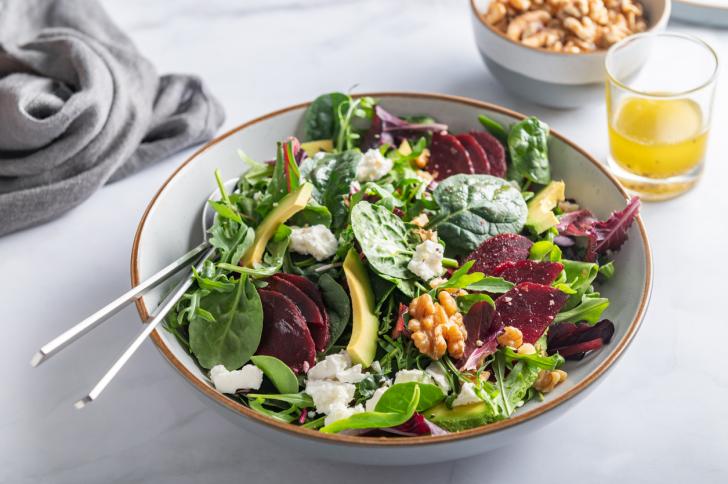How to Grow Your Own Greens and Herbs in Any Space

Published
Growing your own greens and herbs can help reduce the amount of food waste in your household. According to the Environmental Protection Agency, the amount of food waste the US produces equals the amount of greenhouse gas emissions that 42 coal-fired plants produce per year. ¹’² Food waste also accounts for the same water and energy resources used by 50 million homes per year. ¹’² These wasted resources contribute to a large part of the greenhouse gasses we produce. One way to reduce your food waste is to grow your own greens and herbs.
What is Container Gardening?
Gardens thrive in a variety of ways! If you live in an apartment or condominium with no personal yard – not to worry. A small space on your balcony or even inside in a sunny spot near a window will do. Using different-sized pots and containers to grow greens and herbs is just as effective as growing directly in the ground. Many vegetables, fruits, and herbs grow well in their own containers when given soil, fertilizer, and the right amount of water.
Benefits of Container Gardening
Container gardening saves you money, reduces food waste, and helps lower greenhouse gas emissions. Here’s why:
- You don’t have to purchase greens or herbs that you already have growing at home.
- When you harvest your own greens and herbs, you use the leaves or green parts of the pant. The plant root stays intact and allows you to re-harvest many times during the season.
- You can harvest as much or as little as you need, and the plants keep growing more.
- You do not have to purchase more than you need, so you don’t have any waste.
- Greens and herbs in your container garden are harvested right before you use them. There is no transit time from the farm to grocery store to your fridge.
- You don’t have to clean up mushy, unusable heads of lettuce, spinach, or bunches of herbs when they go bad, adding to your food waste!
Steps to Begin Your Container Garden
Container gardens require a little bit of effort to you begin and require water during the dry summer months. If you don’t know where to start, below are three suggestions to help get you begin.
- Visit Your Local Plant Nursery
If you are brand-new to gardening, visit your local plant nursery for information. The knowledgeable and friendly staff can help you gather information about the types of greens and herbs you would like to grow. You can get a good idea of what greens and herbs they sell, what type of containers to use, and what soil they recommend. Some plant nurseries even offer a variety of classes about container gardening!
- Plan Your Space
Different greens and herbs require different growing conditions. Plants can be divided into three basic groups based on how much sunshine they need to thrive: Sun-loving, partial sun, and shade-loving. When planning out your space, you want to group the same kinds of plants together. The table below just gives a few examples of greens and herbs and where they like to grow.
|
Sun³ |
Partial Sun³ |
Shade³ |
|
Rosemary |
Lettuces |
Mint |
|
Oregano |
Microgreens |
Dill |
|
Sage |
Kale |
Parsley |
|
Thyme |
Swiss Chard |
Chives |
Below are a few ideas about how to create your own garden space with a small area:
- Repurpose an old chair or stool on your balcony or porch to arrange the containers for a beautiful display.
- Try using mason jars or tin cans and hang on a sunny spot on your outside wall, fence, or arrange on your windowsill.
- If you don’t have much room, you can use one larger pot and mix several herbs together, grouping sun-loving herbs together in one pot and shade-loving herbs together in another depending on your space.
- Start with Good Materials
Container gardening requires four basic items: containers, soil, fertilizer, and seeds. If you want to get a jump start on your greens and herbs sooner, you can skip the seeds and begin with “starts.” Plant starts are very small plants that you can purchase at your local plant nursery. Here are some tips when looking for the right materials:
- Containers: Plants can grow in containers made of clay, ceramic, or even wood. Make sure these containers have proper drainage. Most containers come with holes on the bottom to allow water to drain and keep the roots from rotting. If you choose a container without holes, you can place larger rocks on the bottom to allow the water to drain through the soil and not collect around the roots.
- Soil: Container gardens need soil. Plant nurseries and home improvement stores sell a wide variety of soils. Make sure you purchase potting soil, specifically for indoors or outdoors depending on where you want your greens or herbs to grow. Look for organic varieties of soil if possible.
- Fertilizer: Containers must provide all the nutrients for your plants to grow and thrive. Many soil brands already have fertilizer in them, but if they don’t consider using a slow-release organic fertilizer. ⁴ Carefully follow the directions on the package as overfertilizing can harm your new plants.
As you experiment with growing your greens and herbs on your patio, balcony, or windowsill, you can save money, enjoy fresh greens and herbs all season, and reduce your food waste. If you are curious to know how to add greens and herbs into your diet and their health benefits, visit our Home page | Bastyr Center for Natural Health or calling our amazing Patient Service Representatives at (206) 834-4100 to make an appointment.
Natalie Rosenbalm is a Dietetic Intern at Bastyr University in Kenmore, WA who serves as a board member of the Greater Seattle Dietetics Association. She is passionate about whole foods nutrition and loves to share how the right foods can help support optimum health. When she isn’t chauffeuring her family around or planning epic trips, she is in the garden or enjoying a walk in her neighborhood with friends.
Resources:
- From Farm to Kitchen: The Environmental Impacts of U.S. Food Waste. US Environmental Protection Agency. November 30, 2021. Updated November 28, 2022. Accessed January 28, 2023. From Farm to Kitchen: The Environmental Impacts of U.S. Food Waste | US EPA.
- Buzby, Jean. Food Waste and its Links to Greenhouse Gasses and Climate Change. USDA. January 24, 2022. Accessed January 28, 2023. Food Waste and its Links to Greenhouse Gases and Climate Change | USDA.
- Raised Beds & Container Gardening. National Agriculture Library. Accessed January 29, 2023. Raised Beds & Container Gardening | National Agricultural Library (usda.gov).
- Organic Fertilizers. WSU Spokane County Extension, Master Gardeners. June 2021. Accessed January 29, 2023. C180-Organic-Fertilizers-21.pdf (wsu.edu).


